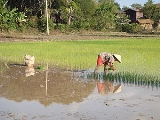
Rural society in Laos
Encyclopedia

Laos
Laos Lao: ສາທາລະນະລັດ ປະຊາທິປະໄຕ ປະຊາຊົນລາວ Sathalanalat Paxathipatai Paxaxon Lao, officially the Lao People's Democratic Republic, is a landlocked country in Southeast Asia, bordered by Burma and China to the northwest, Vietnam to the east, Cambodia to the south and Thailand to the west...
, society is characterized by semiindependent rural villages engaged in subsistence agricultural production. Ethnic, geographic, and ecological differences create variations in the pattern of village life from one part of the country to another, but the common threads of village selfreliance , limited regional trade and communication, and identification with one's village and ethnic group persist regardless of the setting. Rural trade networks, however, have been a part of life since the 1950s. Except near the larger towns and in the rich agricultural plains of Vientiane
Vientiane
-Geography:Vientiane is situated on a bend of the Mekong river, which forms the border with Thailand at this point.-Climate:Vientiane features a tropical wet and dry climate with a distinct monsoon season and a dry season. Vientiane’s dry season spans from November through March. April marks the...
and Savannakhét
Savannakhet
Savannakhet or Kaysone Phomvihane is a city in western Laos and the capital of the Savannakhet Province, previously known as Khanthabouli . This is the second-largest city in Laos, after Vientiane. The city is birthtown of Kaysone Phomvihane, former president of Laos, and was named after him in...
, villages are spaced at least several kilometers apart and the intervening land variously developed as rice
Rice
Rice is the seed of the monocot plants Oryza sativa or Oryza glaberrima . As a cereal grain, it is the most important staple food for a large part of the world's human population, especially in East Asia, Southeast Asia, South Asia, the Middle East, and the West Indies...
paddy and swidden fields or maintained as buffer forest for gathering wild plants and animals, fuelwood, and occasional timber harvest.
Ethnicity differentiates the villages but is usually not a source of conflict or antagonism. Nearly all villages are ethnically homogeneous, although a few include two or more distinct groups. Ethnic mixing often has resulted from different groups migrating to a new settlement site at about the same time, or a larger village at a crossroads or river transit point developing into a minor trading center. Ethnic identity is never absolutely immutable. Some minority Laotian individuals have adopted lowland Lao behavior and dress patterns, or intermarried with lowland Lao, and have effectively acculturated to lowland society. In some units, military service has also brought together Laotians of different ethnic groups, both before and after 1975.
Only since 1975 has there been any sense of national unity among most rural villagers. Precolonial governments depended more on a system of control at the district level with the chao muang (district chief) maintaining his own allegiance and tribute to the state. Administrative practices under the French and during the post-World War II
World War II
World War II, or the Second World War , was a global conflict lasting from 1939 to 1945, involving most of the world's nations—including all of the great powers—eventually forming two opposing military alliances: the Allies and the Axis...
period was confined primarily to provincial and a few district centers. The government was able to extract taxes with some facility but had little impact on the daily lives or thoughts of most villagers. However, since 1975, the government has expended considerable energy and resources on national unification, so that even isolated villages recognize the role of local government and consider themselves at some level to be part of a Laotian state.

